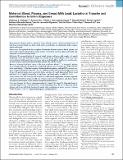| dc.contributor.author | Ettinger, Adrienne S. | en_US |
| dc.contributor.author | Roy, Ananya | en_US |
| dc.contributor.author | Amarasiriwardena, Chitra J. | en_US |
| dc.contributor.author | Smith, Donald | en_US |
| dc.contributor.author | Lupoli, Nicola | en_US |
| dc.contributor.author | Mercado-García, Adriana | en_US |
| dc.contributor.author | Lamadrid-Figueroa, Hector | en_US |
| dc.contributor.author | Tellez-Rojo, Martha Maria | en_US |
| dc.contributor.author | Hu, Howard | en_US |
| dc.contributor.author | Hernández-Avila, Mauricio | en_US |
| dc.date.accessioned | 2014-03-11T13:25:41Z | |
| dc.date.issued | 2013 | en_US |
| dc.identifier.citation | Ettinger, Adrienne S., Ananya Roy, Chitra J. Amarasiriwardena, Donald Smith, Nicola Lupoli, Adriana Mercado-García, Hector Lamadrid-Figueroa, Martha Maria Tellez-Rojo, Howard Hu, and Mauricio Hernández-Avila. 2013. “Maternal Blood, Plasma, and Breast Milk Lead: Lactational Transfer and Contribution to Infant Exposure.” Environmental Health Perspectives 122 (1): 87-92. doi:10.1289/ehp.1307187. http://dx.doi.org/10.1289/ehp.1307187. | en |
| dc.identifier.issn | 0091-6765 | en |
| dc.identifier.uri | http://nrs.harvard.edu/urn-3:HUL.InstRepos:11879526 | |
| dc.description.abstract | Background: Human milk is a potential source of lead exposure. Yet lactational transfer of lead from maternal blood into breast milk and its contribution to infant lead burden remains poorly understood. Objectives: We explored the dose–response relationships between maternal blood, plasma, and breast milk to better understand lactational transfer of lead from blood and plasma into milk and, ultimately, to the breastfeeding infant. Methods: We measured lead in 81 maternal blood, plasma, and breast milk samples at 1 month postpartum and in 60 infant blood samples at 3 months of age. Milk-to-plasma (M/P) lead ratios were calculated. Multivariate linear, piecewise, and generalized additive models were used to examine dose–response relationships between blood, plasma, and milk lead levels. Results: Maternal lead levels (mean ± SD) were as follows: blood: 7.7 ± 4.0 μg/dL; plasma: 0.1 ± 0.1 μg/L; milk: 0.8 ± 0.7 μg/L. The average M/P lead ratio was 7.7 (range, 0.6–39.8) with 97% of the ratios being > 1. The dose–response relationship between plasma lead and M/P ratio was nonlinear (empirical distribution function = 6.5, p = 0.0006) with the M/P ratio decreasing by 16.6 and 0.6 per 0.1 μg/L of plasma lead, respectively, below and above 0.1 μg/L plasma lead. Infant blood lead level (3.4 ± 2.2 μg/dL) increased by 1.8 μg/dL per 1 μg/L milk lead (p < 0.0001, R2 = 0.3). Conclusions: The M/P ratio for lead in humans is substantially higher than previously reported, and transfer of lead from plasma to milk may be higher at lower levels of plasma lead. Breast milk is an important determinant of lead burden among breastfeeding infants. Citation: Ettinger AS, Roy A, Amarasiriwardena CJ, Smith DR, Lupoli N, Mercado-García A, Lamadrid-Figueroa H, Tellez-Rojo MM, Hu H, Hernández-Avila M. 2014. Maternal blood, plasma, and breast milk lead: lactational transfer and contribution to infant exposure. Environ Health Perspect 122:87–92; http://dx.doi.org/10.1289/ehp.1307187 | en |
| dc.language.iso | en_US | en |
| dc.publisher | National Institute of Environmental Health Sciences | en |
| dc.relation.isversionof | doi:10.1289/ehp.1307187 | en |
| dc.relation.hasversion | http://www.ncbi.nlm.nih.gov/pmc/articles/PMC3888576/pdf/ | en |
| dash.license | LAA | en_US |
| dc.title | Maternal Blood, Plasma, and Breast Milk Lead: Lactational Transfer and Contribution to Infant Exposure | en |
| dc.type | Journal Article | en_US |
| dc.description.version | Version of Record | en |
| dc.relation.journal | Environmental Health Perspectives | en |
| dash.depositing.author | Lupoli, Nicola | en_US |
| dc.date.available | 2014-03-11T13:25:41Z | |
| dc.identifier.doi | 10.1289/ehp.1307187 | * |
| dash.contributor.affiliated | Lupoli, Nicola | |


